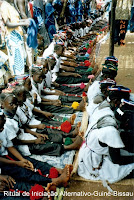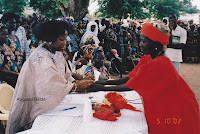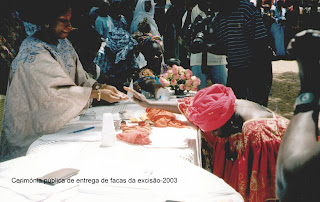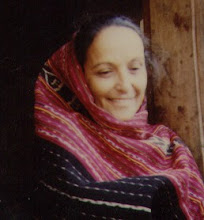


Ritual de Iniciação na Guiné-Bissau – O Fanado
Na Guiné-Bissau todos os grupos étnicos realizam o Fanado (ritual de iniciação).
Para os rapazes ou homens, depende de cada grupo, o Fanado culmina com a circuncisão. Alguns grupos étnicos têm o Fanado das meninas ou jovens mulheres. Nos grupos islamizados o Fanado das meninas culmina com o “corte” (mutilação genital feminina). Em vários grupos o tipo de corte também é diferenciado: remoção total ou parcial do clítoris. Consta-se, ainda, que existem pequenos grupos no norte do país que fazem a infibulação.
O Fanado realiza-se, normalmente, na floresta – em sítios isolados – onde nenhum elemento da comunidade pode entrar durante o período do ritual – 4 a 5 semanas.
Nos centros urbanos o Fanado é realizado nos bairros na periferia das cidades e longe das habitações.
O Fanado é efectuado em terreno sagrado e com a participação e aceitação de várias divindades locais – assim as divindades animistas cruzam-se com as crenças muçulmanas. O Fanado tem os seus próprios protectores espirituais que terão como função não permitir a entrada de pessoas estranhas ao ritual nem de forças malignas. As Fanatecas (excisadoras femininas) e os Fanadores (homens que fazem a circuncisão) são os instrumentos desta ligação entre o mundo real e o mundo espiritual.
Durante esse período os jovens ou crianças adquirem conhecimentos sobre a vida, normas de comportamento dentro da família e da comunidade. Reforça-se o grupo de pertença, ligando as questões étnicas e culturais. Muitas vezes os participantes nos Fanados (crianças, jovens ou adultos) são alvo de violência física e psicológica, como forma de preparação para a vida adulta.
A casa que é construída para o Fanado, “Barraca”, e as esteiras utilizadas no Fanado são queimadas no fim do ritual.
A família é o suporte económico do Fanado: alimentação, roupas, pagamento às pessoas responsáveis no Fanado. Toda a comunidade está envolvida neste ritual de iniciação. O pagamento é feito através de dinheiro ou de bens: arroz, sabão, panos, etc. Este pagamento é uma parte importante e fundamental para o rendimento económico das famílias das Fanatecas (excisadoras).
A participação no Fanado dá às crianças e aos jovens ou aos adultos um estatuto mais elevado dentro do seu grupo étnico. Também lhes possibilita ter acesso a outros níveis de escalões etários – que lhes são vedados ao não participarem nestes rituais.
Uma criança que não ainda não participou no Fanado é chamada de “blufo”. Depois do Fanado são chamadas de “lambés”.
A entrada na casa do Fanado é feita através do chamamento de tocadores de tambor que circulam pelas aldeias ou pelos bairros. É frequente que meninas não muçulmanas sejam motivadas para entrarem no Fanado muçulmano. Quando isto acontece e os pais querem retirar as suas meninas do Fanado há conflitos dentro da comunidade. Segundo a lei do Fanado, quem entra não pode sair. A polícia já foi envolvida em alguns casos de resgate dessas meninas.
Dentro do Fanado há uma cumplicidade entre os participantes e também um pacto de silêncio do que se passa lá dentro. Muito raramente uma pessoa fala do que aconteceu a si próprio ou aos outros. É um assunto tabu.
Mesmo quando há informações de morte dentro do Fanado – as pessoas não relacionam essa morte com o acto da mutilação genital feminina ou circuncisão. Normalmente as justificações para essa morte são de carácter místico externo ao Fanado – intervenção de forças estranhas ao Fanado. Esta forma desresponsabiliza qualquer pessoa que tenha tido intervenção directa ou indirecta na morte.
Quando termina o Fanado as crianças, jovens ou adultos são entregues à comunidade numa grande festa colectiva da passagem ritualista. Os participantes recebem presentes dos familiares e da comunidade.
Tendo o Fanado esta importância e valor dentro da comunidade – não é uma boa estratégia fazer uma luta contra este ritual de iniciação.
Cabe às ONGs locais juntamente com as comunidades encontrar formas de transformar estes rituais de iniciação mais modernos e inovadores e sem a mutilação genital feminina.
No ano de 2001 a 2003 uma ONG local, a Sinim Mira, ONG guineense, com o financiamento de uma ONG alemã, WFD – Weltfriensdienst e.V., implementou 5 Fanados Alternativos, em todo o país, onde participaram 434 meninas. Este Fanado Alternativo era semelhante ao Fanado Tradicional mas sem mutilação das meninas e com módulos formativos na área da educação e saúde. Era a ponte entre a tradição e a modernidade. Este projecto – Projecto Direitos da Mulher (PDM), teve alguns apoios suplementares: Cooperação holandesa, Nações Unidas, Fundação Caloust Gulbenkien (Portugal), etc.
Por falta de financiamentos o projecto ficou suspenso durante 10 anos – o que provocou um voltar atrás na luta contra a MGF na Guiné-Bissau.
Em Abril de 2010 reiniciou-se um projecto na Guiné-Bissau de luta contra a MGF, incluindo, agora, 5 ONGs guineenses e com o apoio da ONG alemã, WFD – Weltfriensdienst e.V. Este projecto chama-se “Djinopi” que significa “Vamos para a frente”.
Paula da Costa – consultora MGF – Guiné-Bissau













